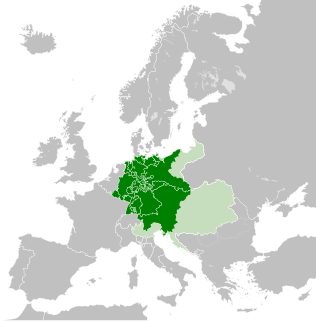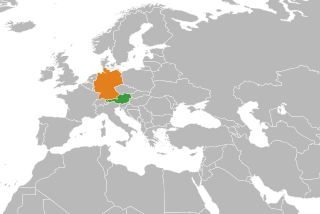
The Holy Roman Empire, often unofficially referred to as the Holy Roman Empire of the German Nation, was a multi-ethnic complex of territories in Western and Central Europe that developed during the Early Middle Ages and continued until its dissolution in 1806 during the Napoleonic Wars. The largest territory of the empire after 962 was the Kingdom of Germany, though it also included the neighboring Kingdom of Bohemia and Kingdom of Italy, plus numerous other territories, and soon after the Kingdom of Burgundy was added. However, while by the 15th century the Empire was still in theory composed of three major blocks—Italy, Germany, and Burgundy—in practice, the links between these blocks had become so unsubstantial that only the Kingdom of Germany remained, nearly all the Italian territories for instance having become in effect part of a narrowly-defined Habsburg dynastic patrimony, unconnected to the Empire. The external borders of the Empire did not change noticeably from the Peace of Westphalia – which acknowledged the exclusion of Switzerland and the Northern Netherlands, and the French protectorate over Alsace – to the dissolution of the Empire. By then, it largely contained only German-speaking territories, plus the Kingdom of Bohemia. At the conclusion of the Napoleonic Wars in 1815, most of the Holy Roman Empire was included in the German Confederation.

The flag of Germany or German flag is a tricolour consisting of three equal horizontal bands displaying the national colours of Germany: black, red, and gold. The flag was first adopted as the national flag of modern Germany in 1919, during the Weimar Republic, until 1933.

The German Confederation was an association of 39 German-speaking states in Central Europe, created by the Congress of Vienna in 1815 as a replacement of the former Holy Roman Empire, which had been dissolved in 1806. The German Confederation did not include some German-speaking lands in the eastern portion of the Kingdom of Prussia, the German-speaking cantons of Switzerland, and the French region of Alsace, which was predominantly German speaking.

The Kingdom of Prussia was a German kingdom that constituted the state of Prussia between 1701 and 1918. It was the driving force behind the unification of Germany in 1871 and was the leading state of the German Empire until its dissolution in 1918. Although it took its name from the region called Prussia, it was based in the Margraviate of Brandenburg, where its capital was Berlin.

The Austrian Empire was a Central European multinational great power from 1804 to 1867, created by proclamation out of the realms of the Habsburgs. During its existence, it was the third most populous empire after the Russian Empire and the United Kingdom in Europe. Along with Prussia, it was one of the two major powers of the German Confederation. Geographically, it was the third largest empire in Europe after the Russian Empire and the First French Empire. Proclaimed in response to the First French Empire, it partially overlapped with the Holy Roman Empire until the latter's dissolution in 1806.
In politics and law, mediatisation is the loss of immediacy, the status of persons not subject to local lords but only to a higher authority directly, such as the Holy Roman Emperor. In a feudal context, it is the introduction of an intervening level of authority between a lord and his vassal so that the former is no longer the immediate lord of the latter, but rather his lordship is mediated by another.

The Confederation of the Rhine was a confederation of client states of the First French Empire. It was formed initially from sixteen German states by Napoleon after he defeated Austria and Russia at the Battle of Austerlitz. The Treaty of Pressburg, in effect, led to the creation of the Confederation of the Rhine, which lasted from 1806 to 1813.

The coat of arms of Germany displays a black eagle with a red beak, a red tongue and red feet on a golden field, which is blazoned: Or, an eagle displayed sable beaked langued and membered gules. This is the Bundesadler, formerly known as Reichsadler. It is one of the oldest coats of arms in the world, and today the oldest national symbol used in Europe.
Imperial immediacy was a privileged constitutional and political status rooted in German feudal law under which the Imperial estates of the Holy Roman Empire such as Imperial cities, prince-bishoprics and secular principalities, and individuals such as the Imperial knights, were declared free from the authority of any local lord and placed under the direct authority of the Holy Roman Emperor, and later of the institutions of the Empire such as the Diet, the Imperial Chamber of Justice and the Aulic Council.

Prince-Primate is a rare princely title held by individual (prince-) archbishops of specific sees in a presiding capacity in an august assembly of mainly secular princes, notably the following:

The Reichsdeputationshauptschluss, sometimes referred to in English as the Final Recess or the Imperial Recess of 1803, was a resolution passed by the Reichstag of the Holy Roman Empire on 24 March 1803. It was ratified by the Emperor Francis II and became law on 27 April. It proved to be the last significant law enacted by the Empire before its dissolution in 1806.

Prince of the Holy Roman Empire was a title attributed to a hereditary ruler, nobleman or prelate recognised as such by the Holy Roman Emperor.

Kleinstaaterei is a German word used, often pejoratively, to denote the territorial fragmentation in Germany and neighboring regions during the Holy Roman Empire and during the German Confederation in the first half of the 19th century. It refers to the large number of virtually sovereign small and medium-sized secular and ecclesiastical principalities and Free Imperial cities, some of which were little larger than a single town or the grounds of the monastery of an Imperial abbey. Estimates of the total number of German states at any given time during the 18th century vary, ranging from 294 to 348 or more.

Relations between Austria and Germany are close, due to their shared history and language, with German being the official language of both countries.
"The German Question" was a debate in the 19th century, especially during the Revolutions of 1848, over the best way to achieve the unification of Germany. From 1815 to 1866, about 37 independent German-speaking states existed within the German Confederation. The Großdeutsche Lösung favored unifying all German-speaking peoples under one state, and was promoted by the Austrian Empire and its supporters. The Kleindeutsche Lösung sought only to unify the northern German states and did not include Austria; this proposal was favored by the Kingdom of Prussia.

In Northern European historiography, the term French period refers to the period between 1794 and 1815 during which most of Northern Europe was controlled by Republican or Napoleonic France. The exact duration of the period varies by the location concerned.

The fourth Peace of Pressburg was signed on 27 December 1805 between Napoleon and Holy Roman Emperor Francis II as a consequence of the French victories over the Austrians at Ulm and Austerlitz. A truce was agreed on 4 December, and negotiations for the treaty began. The treaty was signed in Pressburg, Hungary, by Johann I Josef, Prince of Liechtenstein, and the Hungarian Count Ignác Gyulay for the Austrian Empire and Charles Maurice de Talleyrand for France.

The dissolution of the Holy Roman Empire occurred de facto on 6 August 1806, when the final Holy Roman Emperor, Francis II of the House of Habsburg-Lorraine, abdicated his title and released all imperial states and officials from their oaths and obligations to the empire. Since the Middle Ages, the Holy Roman Empire had been recognized by Western Europeans as the legitimate continuation of the ancient Roman Empire due to its emperors having been proclaimed as Roman emperors by the Papacy. Through this Roman legacy, the Holy Roman Emperors claimed to be universal monarchs whose jurisdiction extended beyond their empire's formal borders to all of Christian Europe and beyond. The formation of the first modern sovereign territorial states in the 16th and 17th centuries, which brought with it the idea that jurisdiction corresponded to actual territory governed, threatened the universal nature of the Holy Roman Empire.














